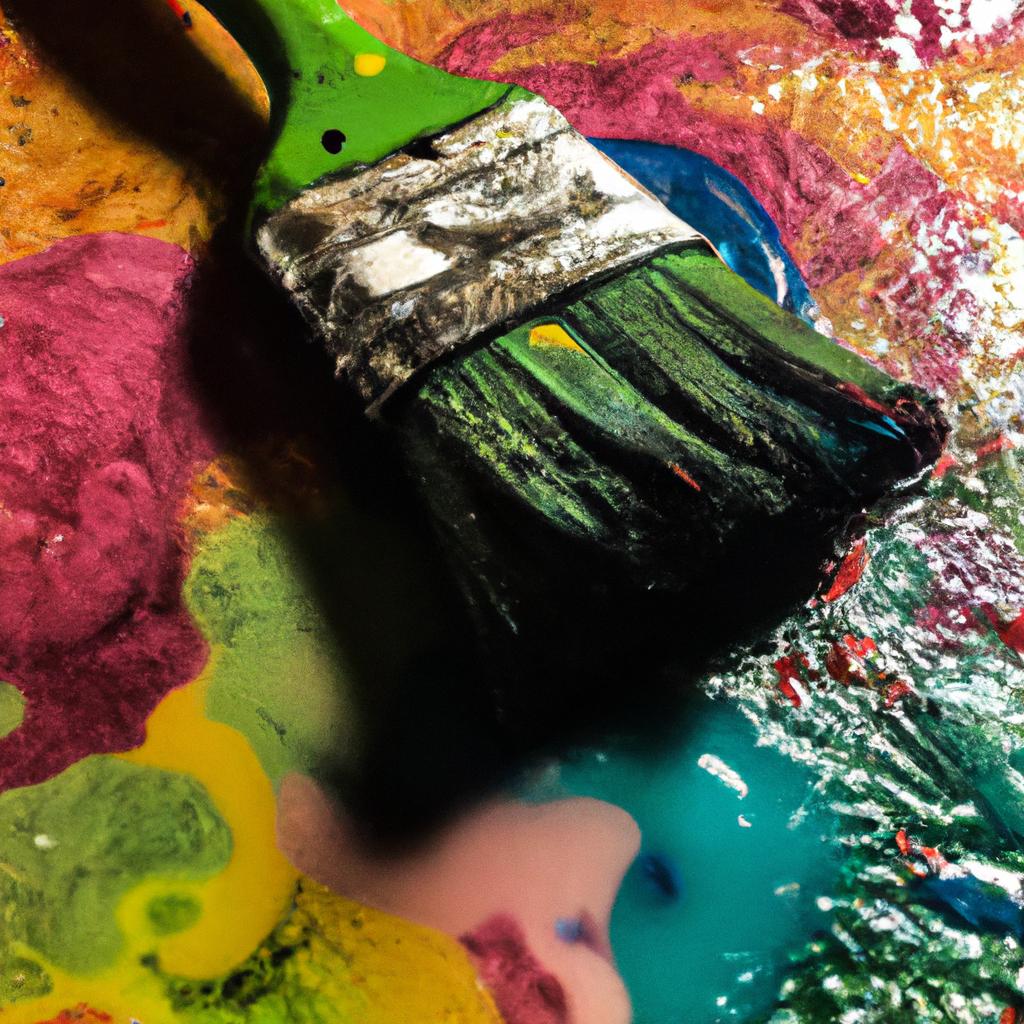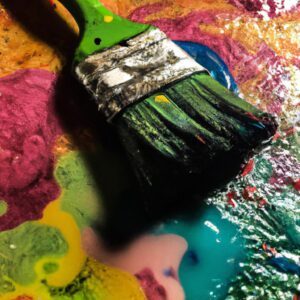Abstract painting is a form of art centered around taking a concept and expressing it without representing the physical world. It has been around for centuries and can be seen in various styles, from bold vibrant colors to simplistic brush strokes. It is a great way to explore creativity and discover unknown forms of self-expression.
Abstract painting is often thought of as non-objective, as the artist typically does not include recognizable figures from the physical world. However, some abstract painters use subtle references to nature when creating their pieces. This type of abstraction often leaves a lot up to interpretation, allowing viewers to make their own unique connections with the artwork.
The origin of abstract painting can be traced back to the Post-Impressionists of the 19th century. Pioneers such as Paul Cezanne, Vincent van Gogh, and Georges Seurat blurred the lines between objective and non-objective art. They paved the way for the many modern artists who use abstraction today. Some of the most famous abstract painters in history are Wassily Kandinsky, Mark Rothko, and Jackson Pollock.
Abstract painting can be an exciting form of creative expression. It is an interesting way to explore color, texture, and emotion in a variety of techniques. Regardless of how abstract a painting looks, its roots can always be traced back to the real world. So, if you’re interested in exploring this distinct art form, the first step is to learn more about the various techniques and supplies used to create abstract paintings.
Different Abstract Painting Techniques
Abstract paintings are often vibrant, complex works of art that are created without a delineated subject. When creating abstract artwork, artists often experiment with a variety of techniques to create movement, harmony, or other visual effects. Here are a few common techniques used in abstract painting:
- Color Blocking: Color blocking is a technique where blocks of color are blended together, sometimes forming an interesting pattern. It can be used to create a mood or atmosphere, and is often seen in modern abstract paintings.
- Stippling: Stippling is the technique of creating a pattern of small dots. By using a range of colors and densities, stippling can be used to create beautiful, subtle images or to add texture to a painting.
- Mark Making: Mark-making is a technique involving the use of lines, shapes and symbols to create unique marks on a canvas. Mark-making can be used to add depth and complexity to an abstract painting.
- Collage: Collage is the technique of arranging multiple different elements on a canvas to create a composition. Elements may include found objects, photos, magazine cutouts, fabric, etc. which are stuck together to form an interesting image or scene.
These are just a few of the many techniques used in abstract painting. As you become more experienced in the craft, you might want to explore and experiment with other methods to find what works best for your own style.
Important Art Supplies Used in Abstract Painting
Abstract painting is a popular art form that allows artists to create unique, visually captivating artwork. To create abstract paintings, a variety of tools and art supplies are needed.
The most important supplies used in abstract painting are paints and brushes. Acrylic and oil paints are most commonly used for creating abstract paintings. The paint can be applied using a variety of painting techniques, including brushwork, spray painting, stippling, and collage. Brushes come in various shapes and sizes, and should be chosen based on the desired effect.
In addition to paints and brushes, canvases are also essential for abstract painting. Canvases come in different shapes, sizes, and textures. Artists often choose larger canvases to create large-scale abstract paintings.
Other art supplies used in abstract painting include markers, pencils, charcoal, pastels, modeling paste, and various textural materials such as sandpaper, stones, and shells.
Using these materials, abstract painters can create vibrant, interesting paintings that combine color, texture, and line to express their unique vision.
Creating a Meaningful Painting vs. Working Spontaneously
Abstract painting is a journey of discovery and experimentation. It allows you to explore your creativity without the need for a precise outcome. Whether you’re looking to create a meaningful painting or prefer to work spontaneously, both approaches can be rewarding in their own ways.
When creating a painting with an intended meaning, the artist can convey a certain message or emotion through abstract forms and colors. This type of artwork encourages deep and thoughtful thinking about the underlying ideas and concepts. On the other hand, working spontaneously gives the artist more freedom to express their ideas without any specific end goal. This method of painting allows for experimentation and the unexpected.
Both approaches have their benefits and drawbacks. For example, creating a meaningful painting can be very rewarding when the artist is able to successfully communicate their ideas, however this type of painting also requires a lot of planning and research before the painting begins. Whereas, working spontaneously can lead to interesting and unique results but it may also be difficult to know where to start or where the painting may take you.
Whether you choose to create a meaningful painting or prefer to work spontaneously, abstract painting is an exciting way to explore your creative side. Experimentation is key to finding success as an abstract painter so don’t be afraid to try new techniques and materials.
Tips To Get Started & Inspire Your Work
As any creative art form, getting started with abstract painting is not always an easy task. There are many ways to get inspiration for your next painting and to get started. Here are some tips to help you.
- Browse through galleries or stores: Whether online or in real life, looking at other people’s works can be inspiring and give you ideas for your own work.
- Read books or watch videos on abstract art: Doing research into the art form can be a great way to get inspired, as well as acquire new knowledge and techniques.
- Take walks and observe nature: Looking at the way light plays on natural objects, such as texture or color, can be extremely inspiring.
- Experiment with different materials: Trying out new colors, combinations, and even materials, such as paper mache, soil, or thread, can be liberating and often lead to unexpected results.
When you’re ready to start, give yourself time and space for creativity and experimentation. Take breaks when needed, and don’t be afraid to try something new. Through practice, you will find the techniques and creative approach that best suit your style.
Popular Artists Who Paint Abstract Art
Abstract art has long been considered an important artistic genre, with its roots going back centuries. To this day, abstract painting is practiced by many artists around the world. In this section, we will explore a few of the most renowned abstract artists throughout history and learn more about what they are known for and their contributions to the practice.
Wassily Kandinsky (1866-1944)
Wassily Kandinsky was a pioneer in abstract art who began his career in the early 20th century. He is known as one of the first painters to develop a completely non-representational style of painting. His works often contained basic geometric shapes and vibrant colors to convey his inner emotions.
Piet Mondrian (1872-1944)
The Dutch painter Piet Mondrian was also an influential figure in abstract art. He believed that art should represent only universal truths and express harmony and unity. As a result, his works mainly featured simple fixed grids and primary colors.
Mark Rothko (1903-1970)
Mark Rothko was an American-born painter who was recognized for his unique style of abstract expressionism. Rothko combined bold colors, mysterious shapes and large fields of space in his works to create a powerful sense of emotion that could deeply affect the viewer.
Jackson Pollock (1912-1956)
Jackson Pollock was an American painter who developed a style of painting called “action painting” or “drip painting”. In this style, Pollock dripped, splattered, and poured paint onto large canvases. His works often feature swirling, chaotic patterns that conveyed a sense of energy and motion.
These four artists are just a few examples of the many talented abstract painters throughout history. Each artist brought something unique to the practice, pushing the boundaries of the genre and inspiring future generations of abstract artists.
It’s time to wrap things up and look at the bigger picture of abstract painting. We explored what abstract painting is, various techniques used, the supplies needed, ways to inspire your work, popular artists, and the importance of experimentation with this creative art form.
Abstract painting is an incredible form of artistic expression that can be used to create unique and meaningful works of art. It is a great way to tap into our creativity and unlearn the conventional methods of artistic expression. The possibilities are endless and by experimenting with different techniques and styles, nothing is off-limits.
Whether you are just starting out or have been painting abstract art for many years, the key to unlocking your true potential lies in experimentation. Try new techniques, explore new approaches, and allow yourself to take risks. The more you experiment, the more your skills will improve and you will be able to create beautiful abstract paintings that represent your vision.
comments: 0

